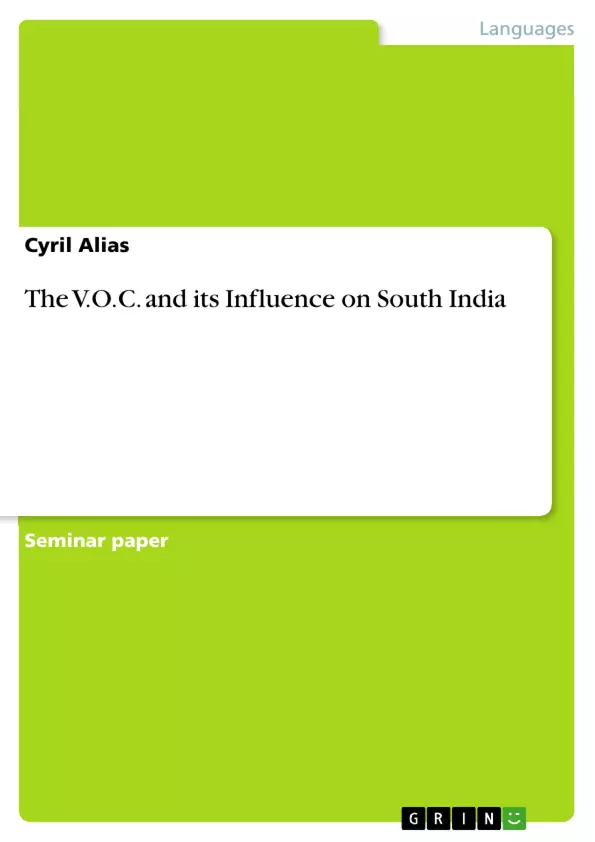The Netherlands have a long heritage in trading and were once a mighty colonial power due to its outstanding naval power. Symbol of this trading and sea power was the Vereenigde Oostindische Compagnie (V.O.C.), “the most powerful multinational in the history of the world” , which endured nearly two entire centuries., India, on the other hand, was the possibly most sought destination those days. Not only owing to its wealth of spices and raw materials, many European nations have sought their way to India and its riches. The Dutch conquered the southern parts of India, such as Malabar and Coromandel and affected the subcontinent in many terms, pursuing mainly trading purposes.
The question arising from the relatively short presence of the Dutch and the V.O.C. on the Indian subcontinent aims at the extent to which that presence affected current India.
Which aspects were brought to the Indian subcontinent by the Dutch seafarers of the V.O.C.? Which effects did the presence of the Dutch have on South Indian history? In how far was this era decisive to both the V.O.C.’s and India’s destiny?
In order to understand the interrelations better, the V.O.C. and its history shall be introduced thoroughly in the beginning. Reasons for both the rapid increase in prosperity and for the decay of the global trading empire are to be explained as well as the extent of the sphere of the operations of the V.O.C.
Then, a close-up to the Dutch East India Company in India in ancient times will follow, concentrating on both political and economical issues, on the one hand, and on other ancillary aspects, on the other one. Derived from this part, an analysis of current legacy in India, hinting at the era of occupation by the Dutch, will be attached to the essay.
Finally, a completing point of view shall be taken in order to draw a conclusion regarding the Dutch influence on the Southern India of today.
Inhaltsverzeichnis (Table of Contents)
- Introduction
- The Vereenigde Oostindische Compagnie
- The Boom
- The Fall
- The Vereenigde Oostindische Compagnie In India
- The Past And The Present
- Conclusion
Zielsetzung und Themenschwerpunkte (Objectives and Key Themes)
This essay aims to analyze the influence of the Vereenigde Oostindische Compagnie (VOC) on South India and explore its lasting impact on the region.
- The rise and fall of the VOC as a global trading empire
- The VOC's presence in South India, particularly Malabar and Coromandel
- The economic and political impact of the VOC on the Indian subcontinent
- The legacy of the VOC in contemporary South India
Zusammenfassung der Kapitel (Chapter Summaries)
The introductory chapter establishes the historical context of the VOC, highlighting its role as a dominant colonial power in the 17th and 18th centuries. It outlines the motivations behind the VOC's expansion into South India, focusing on its pursuit of spices and other valuable commodities.
The second chapter details the remarkable growth of the VOC, examining its origins, its acquisition of a monopoly on trade with the East Indies, and its significant capital investments. The chapter also discusses the VOC's military operations in the East, highlighting its victories over rivals like the Portuguese.
The third chapter focuses on the VOC's activities in South India, exploring its trade networks, settlements, and political interactions with local rulers. It analyzes the economic impact of the VOC on the region, including its influence on the spice trade and its introduction of new technologies.
Schlüsselwörter (Keywords)
The central themes and concepts in this essay include the Vereenigde Oostindische Compagnie (VOC), colonial trade, South India, Malabar, Coromandel, spice trade, economic impact, political influence, and cultural exchange.
- Citar trabajo
- Cyril Alias (Autor), 2006, The V.O.C. and its Influence on South India, Múnich, GRIN Verlag, https://www.grin.com/document/89969



